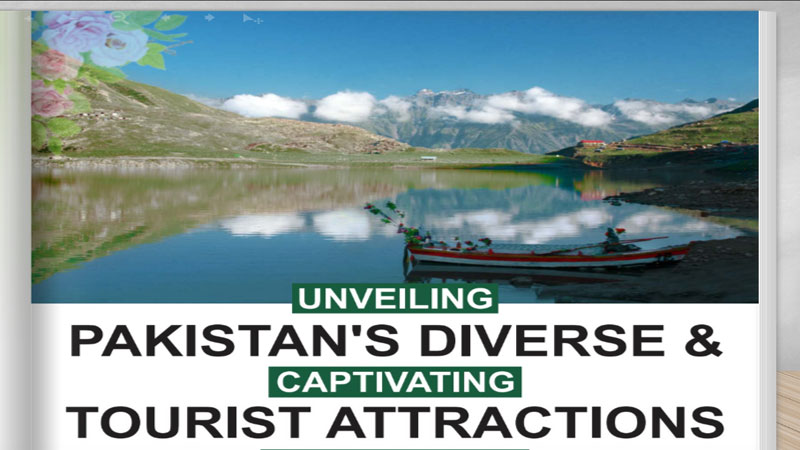Nestled in South Asia, Pakistan is a country that invites fearless travellers with its diverse landscapes, rich cultural heritage, and warm hospitality. Despite being overshadowed by other destinations, Pakistan boasts numerous attractions that enchant and captivate visitors. From towering mountain ranges and ancient architectural marvels, to vibrant cities and stunning natural wonders, Pakistan's tourism potential is as vast as its storied history. This essay delves into the intricacies of the main attractions that attract tourists to explore the enchanting tapestry of Pakistan.
1. The Mighty Peaks of the Himalayas and Karakoram: Pakistan is blessed with some of the world's most breathtaking mountain ranges, including the Himalayas and Karakoram. These majestic peaks, adorned with snow-capped summits, offer a paradise for adventure enthusiasts and nature lovers alike. The iconic K2, the second-highest peak globally, is a magnet for mountaineers and climbers seeking an awe-inspiring challenge. The Himalayan region of Gilgit-Baltistan is home to gems like Nanga Parbat and Rakaposhi, offering breathtaking scenes and thrilling adventures.
2. Enchanting Valleys and Pristine Lakes: Pakistan's valleys are a testament to its ethereal natural beauty. The Hunza Valley, nestled in the Karakoram Range, is a paradise of turquoise lakes, cascading waterfalls, and cherry blossom trees. The Neelum Valley in Azad Kashmir captivates visitors with its lush meadows, gushing rivers, and enchanting streams. The Swat Valley, known as the "Switzerland of the East," boasts panoramic views, alpine forests, and meandering rivers. These valleys are complemented by the presence of captivating lakes such as Lake Saiful Muluk, Lake Attabad, and Satpara Lake, all of which offer atmosphere amidst nature's splendor.
3. Cultural and Historical Heritage: Pakistan's rich cultural and historical heritage spans over millennia, offering a tapestry of civilizations and archaeological wonders. The ancient city of Mohenjo-daro, a UNESCO World Heritage site, showcases the remnants of the Indus Valley Civilization, dating back to 2500 BCE. The city of Taxila, renowned for its Buddhist heritage, hosts well-preserved ruins and monasteries from the Gandhara civilization. Lahore, the cultural capital, reveals architectural marvels from the Mughal era, such as the Badshahi Mosque, Lahore Fort, and Shalimar Gardens. The city of Multan boasts a rich Sufi heritage, evident in its magnificent shrines and bustling bazaars.
4. Bustling Metropolises: Pakistan's bustling cities provide a vibrant blend of modernity, traditional charm, and a glimpse into the country's urban life. Karachi, the largest city, offers a bustling cosmopolitan experience with its vibrant markets, historical sites like Mohatta Palace, and a thriving food scene. Islamabad, the capital, showcases meticulously planned streets, lush green parks, and modern infrastructure. Lahore, known for its love for arts, literature, and cuisine, treats visitors to vibrant festivals, traditional music, and mouthwatering delicacies.
5. Coastal Charms and Marine Delights: Pakistan's coastline along the Arabian Sea is dotted with stunning beaches and coastal treasures. The Makran Coastal Highway presents a scenic drive along the coastline, passing through breathtaking landscapes and small fishing villages. The coastal towns of Gwadar, Ormara, and Kund Malir offer pristine beaches with golden sands, azure waters, and dramatic cliffs. Visitors can indulge in water sports, relax on the shores, or savor freshly caught seafood while immersing themselves in the warm hospitality of the locals.
Spiritual Tourism and Places in Pakistan
Pakistan is a country with a rich spiritual heritage, home to numerous sacred sites and religious destinations that attract spiritual seekers from around the world. Here are some prominent spiritual tourism places in Pakistan:
1. Data Darbar (Lahore): Located in the heart of Lahore, Data Darbar is the shrine of the renowned Sufi saint Hazrat Data Ganj Bakhsh. It is one of the most important and revered Sufi shrines in South Asia and attracts a large number of devotees seeking blessings and spiritual solace.
2. Shrine of Lal Shahbaz Qalandar (Sehwan Sharif): Situated in the town of Sehwan Sharif in Sindh province, this shrine is dedicated to the Sufi saint Lal Shahbaz Qalandar. It is a significant pilgrimage site for Sufi devotees, particularly during the annual Urs festival, where vibrant celebrations and mystical music (Qawwali) take place.
3. Kartarpur Sahib (Narowal): Kartarpur Sahib is a historic gurdwara located near the border between Pakistan and India. It holds immense importance for Sikhs as it is the final resting place of Guru Nanak Dev, the founder of Sikhism. The opening of the Kartarpur Corridor has made it accessible for Sikh pilgrims to visit the gurdwara.
4. Shah Rukn-e-Alam Shrine (Multan): This mausoleum is dedicated to the Sufi saint Hazrat Shah Rukn-e-Alam. It is an architectural marvel and a symbol of spiritual devotion in Multan. The annual Urs festival attracts devotees from different parts of the country who come to pay their respects.
5. Hinglaj Mata Temple (Balochistan): Situated in the Hingol National Park in Balochistan, Hinglaj Mata Temple is a Hindu pilgrimage site. Devotees believe it to be the abode of the goddess Hinglaj, and the temple complex hosts annual festivals and religious ceremonies, drawing a significant number of Hindu pilgrims.
6. Roza-e-Rasool (Medina Mosque, Lahore): Also known as Medina Mosque, Roza-e-Rasool is a replica of the Prophet Muhammad's (PBUH) mosque in Medina, Saudi Arabia. It is a place of reverence for Muslims, offering a serene environment for prayers and contemplation.
7. Gurdwara Panja Sahib (Hassan Abdal): Situated in Hassan Abdal, Punjab, Gurdwara Panja Sahib holds great significance for Sikhs. It is believed to be the place where Guru Nanak Dev left his handprint, which is imprinted on a boulder inside the gurdwara.
8. Katas Raj Temples (Chakwal): The Katas Raj Temples complex is a group of historic Hindu temples in Chakwal, Punjab. It is revered by Hindus as a sacred site associated with Lord Shiva and draws pilgrims who seek spiritual blessings and immerse themselves in the architectural beauty.
These spiritual destinations offer a profound spiritual experience and a glimpse into Pakistan's diverse religious heritage. They provide a space for contemplation, devotion, and the opportunity to connect with a higher power, making Pakistan an important destination for spiritual tourism.
Popular tourist places in Pakistan
- Lahore: Known as the cultural capital, Lahore offers architectural marvels like the Badshahi Mosque, Lahore Fort, and Shalimar Gardens. The city also hosts vibrant festivals, delicious street food, and traditional arts and crafts.
- Islamabad: The capital city showcases well-planned streets, lush green parks, and modern infrastructure. It is home to iconic landmarks like Faisal Mosque, Daman-e-Koh viewpoint, and Pakistan Monument.
- Karachi: Pakistan's largest city, Karachi, is a bustling metropolis offering historical sites, including Mohatta Palace and Quaid-e-Azam Mausoleum. The city's vibrant markets, beautiful beaches, and diverse culinary scenes are also major attractions.
- Gilgit-Baltistan: This region in northern Pakistan is renowned for its majestic mountains, including Nanga Parbat and Rakaposhi. The Hunza Valley, Skardu, and Fairy Meadows are popular destinations for their stunning landscapes and cultural heritage.
- Swat Valley: Known as the "Switzerland of the East," Swat Valley captivates visitors with its alpine scenery, meandering rivers, and historical sites like the Buddhist ruins at Jahanabad.
- Neelum Valley: Located in Azad Kashmir, the Neelum Valley is a picturesque region adorned with lush meadows, gushing waterfalls, and the scenic Neelum River. It offers opportunities for hiking, camping, and exploring pristine natural beauty.
- Hunza Valley: Nestled in the Karakoram Range, Hunza Valley enthralls visitors with its turquoise lakes, cherry blossom trees, and the iconic Baltit Fort. The region is also famous for its hospitality and traditional music.
- Mohenjo-daro: A UNESCO World Heritage site, Mohenjo-daro showcases the remnants of the ancient Indus Valley Civilization, dating back to 2500 BCE. It is one of the world's oldest planned cities.
- Taxila: Located near Islamabad, Taxila is an important archaeological site that preserves the ruins of the Gandhara civilization. The area boasts Buddhist monasteries, stupas, and a museum showcasing ancient artefacts.
- Gwadar: Situated on the Arabian Sea coastline, Gwadar is a rapidly developing port city with pristine beaches, stunning cliffs, and opportunities for water sports. It is an emerging tourist destination with a unique blend of natural beauty and modern development.
- Lake Saiful Muluk: Located in the Himalayas, Lake Saiful Muluk is renowned for its enchanting beauty, crystal-clear waters, and surrounding snow-capped peaks. It offers a serene retreat for nature lovers and photographers.
- Fairy Meadows: Situated at the base of Nanga Parbat, Fairy Meadows is a picturesque meadow offering breathtaking views of the mountain. It is a popular spot for camping, trekking, and enjoying the beauty of nature.
These are just a few highlights from the diverse range of tourist places in Pakistan. Each destination offers its own unique charm, cultural heritage, and natural beauty, making Pakistan a truly enchanting country to explore.
Recommendations for Attracting Tourists in Pakistan
To attract more tourists to Pakistan, it is essential to focus on various aspects of tourism promotion and development. Here are some recommendations to attract tourists to Pakistan:
1. Strengthen Marketing and Promotion: Invest in targeted marketing campaigns both domestically and internationally to create awareness about Pakistan's tourism potential. Utilize various platforms such as social media, travel websites, and international travel fairs to showcase the country's diverse attractions, cultural heritage, and natural beauty. Collaborate with travel influencers, bloggers, and photographers to highlight the unique experiences that Pakistan offers.
2. Improve Infrastructure and Connectivity: Upgrade and enhance transportation infrastructure, including airports, roads, and railways, to facilitate easy and convenient travel across the country. Develop new domestic and international air routes to improve connectivity to major cities and tourist destinations. Enhance public transportation systems and promote eco-friendly modes of transportation to provide visitors with a smooth travel experience.
3. Enhance Tourist Facilities: Invest in the development of quality accommodations, ranging from luxury hotels to budget-friendly guesthouses, in popular tourist destinations. Encourage private sector investment in the hospitality industry to increase the availability of diverse accommodation options. Focus on providing international standards of service, cleanliness, and safety to enhance the overall visiting experience.
4. Preserve and Promote Cultural Heritage: Preserve and restore historical sites, monuments, and archaeological treasures across the country. Create visitor-friendly facilities, such as guided tours, informative signage, and visitor centers, to enhance the understanding and appreciation of Pakistan's rich cultural heritage. Organize cultural festivals, exhibitions, and events to showcase traditional arts, music, and cuisine.
5. Develop Adventure Tourism: Capitalizing on Pakistan's stunning mountain ranges and natural landscapes, develop adventure tourism opportunities such as mountaineering, trekking, hiking, paragliding, and river rafting. Establish safety protocols, provide necessary equipment, and ensure trained guides to ensure a safe and enjoyable adventure experience for tourists. Collaborate with international adventure travel organizations to promote Pakistan as an adventure tourism destination.
6. Eco-Tourism and Conservation: Emphasize the importance of sustainable and eco-friendly tourism practices to preserve Pakistan's pristine natural beauty. Encourage responsible tourism by promoting waste management, minimizing carbon footprints, and preserving biodiversity. Develop eco-tourism initiatives in collaboration with local communities to provide sustainable livelihoods and protect natural resources.
7. Streamline Visa Processes: Simplify visa processes and provide e-visa facilities to make it easier for international tourists to visit Pakistan. Establish visa-on-arrival facilities at major airports to facilitate hassle-free entry for eligible travellers. Promote visa-free travel agreements and reciprocal visa facilitation with countries that have significant tourism potential.
8. Enhance Safety and Security: Ensure the safety and security of tourists by implementing robust security measures, particularly in popular tourist areas. Collaborate with law enforcement agencies to establish tourist police units and helplines to address any concerns or emergencies faced by the visitors. Promote a positive and welcoming image of Pakistan by fostering a culture of hospitality and friendliness towards tourists.
By implementing these recommendations, Pakistan can effectively attract more tourists, promote sustainable tourism practices, and unlock the true potential of its diverse attractions.


